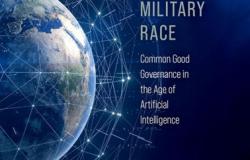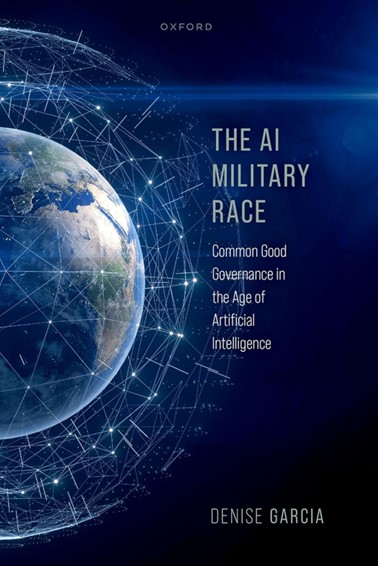Book Review - The AI Military Race: Common Good Governance in the Age of Artificial Intelligence

The AI Military Race: Common Good Governance in the Age of Artificial Intelligence by Denise Garcia. Oxford: Oxford University Press 2023. 320 pp., £30 hardcover 9780192864604
Denise Garcia’s The AI Military Race: Common Good Governance in the Age of Artificial Intelligence is a valuable contribution to the growing literature on a complex and rapidly evolving topic—the military uses of artificial intelligence (AI). She observes that the militarization of AI will, and already is, significantly impacting global peace and security, and relations between states. Garcia argues that there is an urgent need to build international norms on the basis of ‘common good governance’, a framework that she details throughout the book. By zooming in on a particular aspect of militarized AI—the development of autonomous weapon systems, or so-called ‘killer robots’—Garcia argues that ‘transnational networked cooperation’ presents the best response to the weaponization of technology and for safeguarding human security.
 Garcia begins by presenting the state of play concerning the extent to which AI can and is being invested in and used by the militaries of a few “technologically powerful countries” (p.7). The volume then narrows to focus in mainly on the issue of autonomy in weapon systems. As Garcia notes, the use of autonomy and AI computation in military operations is not the problem per se; the lack of adequate human involvement in overseeing the life-cycle stages of weapon design and operations are what is most concerning, particularly when AI and machine learning are used as the basis for selecting and engaging with targets: “In other words, it is the delegation of decisions to target and to kill to an autonomous system, and to an algorithm, that is more likely to contravene moral, ethical, and legal frameworks.” (p.10).
Garcia begins by presenting the state of play concerning the extent to which AI can and is being invested in and used by the militaries of a few “technologically powerful countries” (p.7). The volume then narrows to focus in mainly on the issue of autonomy in weapon systems. As Garcia notes, the use of autonomy and AI computation in military operations is not the problem per se; the lack of adequate human involvement in overseeing the life-cycle stages of weapon design and operations are what is most concerning, particularly when AI and machine learning are used as the basis for selecting and engaging with targets: “In other words, it is the delegation of decisions to target and to kill to an autonomous system, and to an algorithm, that is more likely to contravene moral, ethical, and legal frameworks.” (p.10).
The book goes on to describe efforts from the scientific and technology communities, international organizations like the International Committee of the Red Cross (ICRC), and global civil society more broadly to challenge the development and use of autonomous weapons, notably through a diplomatic process at the United Nations (UN). Garcia helpfully details not only the history of this process and its related political dynamics, but she also describes the applicability of international law and relevant political frameworks to the issue, including where they fall short or raise fundamental questions. This is the basis from which Garcia posits that because of the extent to which the weaponization of AI disrupts international law, new norms and laws are required. To this end, she highlights the global efforts to achieve a treaty banning autonomous weapons and in particular the work of the Campaign to Stop Killer Robots, a civil society-led advocacy coalition over the last decade. Herein lies what I took to be her central call to action—a treaty to prohibit autonomous weapons.
In different sections of the book, Garcia points to earlier successful cooperation and international law-making in other areas—the bans on nuclear and chemical weapons; legal restrictions on conventional arms; and agreements that govern global commons such as the ozone, the oceans, and outer space. Garcia argues that previous successes in global cooperation can inform the development of common good governance on military uses of AI, notably autonomous weapons. She identifies several common precepts that unite efforts in these areas, including frameworks to reduce distrust, precautionary frameworks, a role for science and the scientific community, and the creation of spheres of peace.
Foundational to Garcia’s overarching thesis are the mutually reinforcing concepts of common good governance and transnational networked cooperation. Both are reiterated and stressed continuously throughout the volume. As she explains, common good governance arises from “the combined efforts of multiple governments and other entities’ endeavoring to create global public goods to ensure the mutual benefit and common good of all peoples.” (p.22). It occurs when different networks and communities work together to cooperatively address a mutual challenge. Not surprisingly then, her articulation of transnational networked cooperation “offers an inclusive way to look at the solutions for the contemporary problems of global cooperation.” She presents five requisite criteria for such cooperation: authoritative knowledge, precautionary governing frameworks, the presence of epistemic communities, the existence of transnational advocacy networks, and cooperation to promote urgency (p.40). Underwriting both concepts is a third critical pillar of Garcia’s volume, humanity’s security.
Overall, the volume is a significant contribution to academic literature on a topic that is not only complex but rapidly evolving and therefore challenging to explain and keep abreast of. Garcia deftly navigates and presents in relatively equal degrees the ethical, technical, legal, policy, and diplomatic dimensions of the autonomous weapons issue. She helpfully presents and breaks down complex topics like meaningful human control, and frameworks including international humanitarian law in ways that are highly accessible, and that acknowledge where there are differences in opinion and approach. I also found her approach of looking at what has worked in other issue and threat areas valuable, having undertaken a similar approach in my recently published study of cyber accountability.
The author’s mapping of the contributions of diverse stakeholders over the last decade, including from the private sector, the scientific community, technologists, academia, activists and others accurately portrays the breadth of concerns and perspectives that exist about “killer robots”, thereby making a robust argument against these weapon systems. She effectively situates her call to action on killer robots within a broader set of concerns and trends about the militarization and weaponization of technology, and the importance of safeguarding what she refers to as ‘humanity’s security’. While the author does not shy away from advocating for her own perspectives and positions, she acknowledges and to some extent explains opposing views and approaches to the killer robots issue. In some places, she further unpacks how divergent views on ideas like meaningful human control have become obstacles to agreeing new norms or policies.
A particularly unique value add of this publication is the author’s personal experience as a participant in several of the initiatives that she describes. This enables a closer look inside of negotiating rooms and campaigning initiatives than is often seen in academic research and helps to capture the complexity and challenges involved in rendering change. It also helps to demonstrate the widening gulf between technological advancement and the efforts of policymakers, in a bid for urgent solutions.
Like any publication on a topic that is rapidly evolving, there is a risk that real-world events will outpace what is captured in this volume. As well, readers who are seeking a wider examination of the role of AI in militaries may find the book’s focus on autonomous weapons somewhat limiting. It can also be at times slightly repetitive of arguments or concepts that surface frequently but are sometimes presented differently, which in some places can be challenging for a reader. That said, by reiterating the core concepts on which the volume is premised and rooting her research in both theory and policy, Garcia compellingly constructs a sound argument for why and how to challenge the weaponization of technology.
Allison Pytlak is the Senior Fellow and Director of the Cyber Program at the Stimson Center. In her former role with the Women's International League for Peace and Freedom, Pytlak served on the Steering Committee of the Campaign to Stop Killer Robots.

